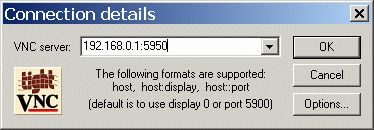36.4 Starting Remote Management Operations Using the Native VNCViewer
The following sections contain additional information:
36.4.1 Starting Remote Management Operations Using the Windows VNC Viewer
-
Download the latest stable version of the native VNC Viewer from the TightVNC web site.
-
Install Tight VNC from the executable you have downloaded.
-
Launch the Tight VNC Viewer from Start > Programs > Tight VNC > Tight VNC Viewer.
IMPORTANT:We recommend using Tight VNC Viewer (Fast Compression) over fast links and Tight VNC Viewer (Best Compression) over slow links.
-
In , specify the IP address with a port number as configured, then click .
You can specify the port number after the IP address with a double colon (::) preceding it. For example, if the IP address of the managed device is 192.168.0.1, and the Remote Control Service port number is 5950, specify as 192.168.0.1::5950.
You can specify the display number after the IP address with a single colon (:) preceding it. For example, if the IP address of the managed device is 192.168.0.1, and the Remote Control Service port number is 5950, specify the IP address as 192.168.0.1:50.
You can also specify a DNS name instead of an IP address.

-
In , specify the correct password, then click .

Now, you will have an access to the desktop of the managed device you have specified.
36.4.2 Starting Remote Management Operations Using the Linux VNC Viewer
-
Download the latest stable version of native VNC Viewer from the TightVNC Web site at TightVNC web site.
-
Install Tight VNC from the RPM Package you have downloaded.
-
Launch Tight VNC Viewer by specifying the following command at the Shell prompt:
$ vncviewer
-
In serverDialog, specify the IP address with a port number as configured, then click .

You can specify the port number after the IP address with a double colon (::) preceding it. For example, if the IP address of the managed device is 192.168.0.1, and the Remote Control Service port number is 5950, specify the IP address as 192.168.0.1::5950.
You can specify the display number after the IP address with a single colon (:) preceding it. For example, if the IP address of the managed device is 192.168.0.1, and the Remote Control Service port number is 5950, specify as 192.168.0.1:50.
-
In passwordDialog, specify the correct session password, then click .

Now, you will have an access to the desktop of the IP address you have specified.